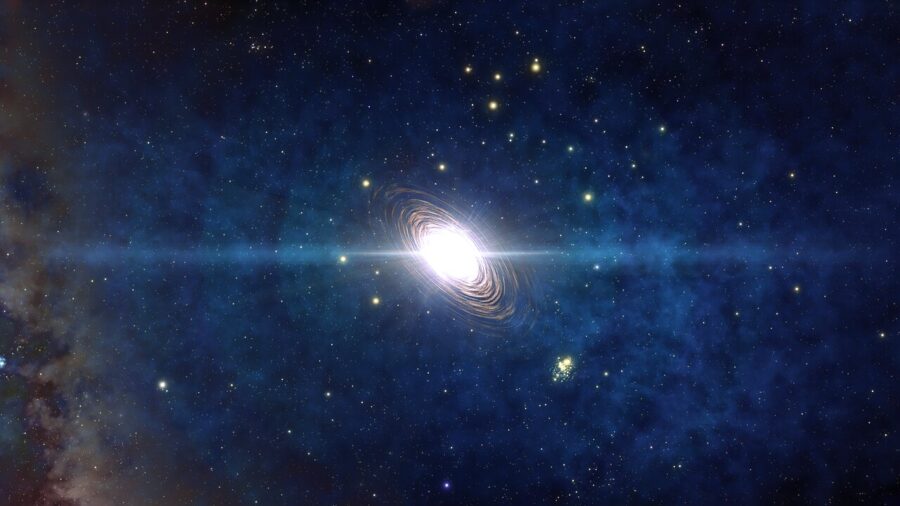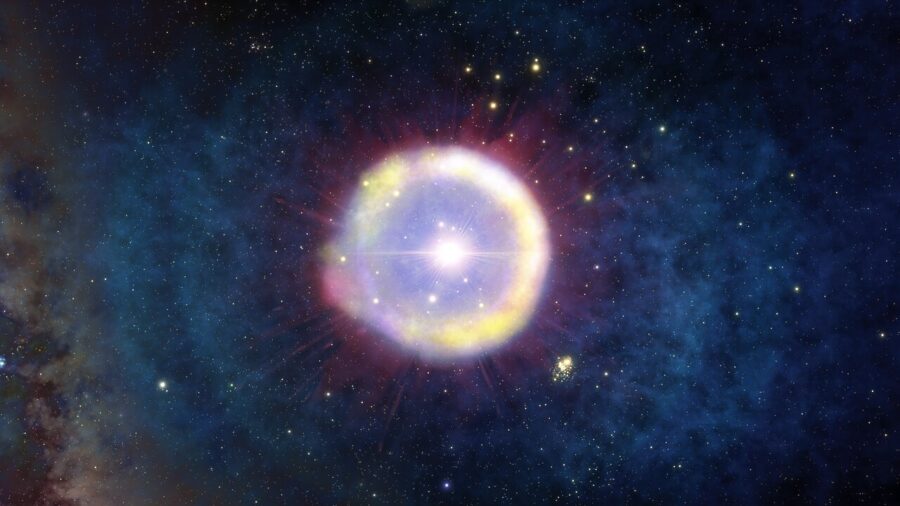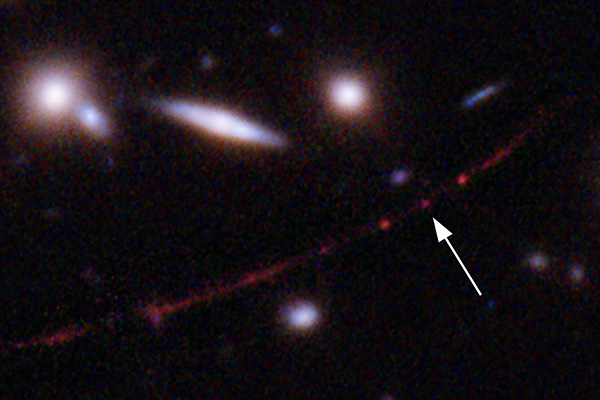Scientists have detected something unusual around a distant quasar — perhaps the first real evidence of a first-generation star.

NOIRLab / NSF / AURA / J. da Silva / Spaceengine
Big Bang cosmology tells us that the early universe was made up of only hydrogen, helium, and a smattering of lithium. From this, we can reason that the first generation of stars would have been quite different from the stars around us today. We’ve never seen this first generation— the first stars are too far away to image directly. But now, we have tentative evidence that they really did exist, and in the pure form astronomers had predicted.
The first stars were “pure” in the sense that they must have been free of metals, the term astronomers use to mean any elements heavier than hydrogen and helium. For historical reasons, we call these stars Population III (Pop III). Because they were missing metals, these stars were huge, with hundreds of Suns’ worth of mass. Astronomers have hypothesized that some of them ended their lives in a peculiar kind of explosion called a pair-instability-supernova (PISN).

NOIRLab / NSF / AURA / J. da Silva / Spaceengine
Unlike most supernovae we observe, a PISN does not leave behind a black hole or neutron star— just gas leftover from a shredded star. Subsequent generations of stars — Pop II, then Pop I — were formed from the heavier elements left behind. Neither Pop III stars, nor the explosions they ended in, have ever been directly observed. But a recent article in The Astrophysical Journal claims to have found evidence of this peculiar type of supernova in the gas around ULAS J1342, one of the most distant quasars known.
Yuzuru Yoshii (The University of Tokyo), who led the project, has been researching no-metal and low-metal stars since the 1990s. His team analyzed spectra of the gas around the quasar, collected with the Gemini North telescope on Mauna Kea in Hawai‘i, converting the intensity of light emitted by specific heavy elements into abundances of those elements. The results were intriguing, showing much less magnesium relative to iron than expected. This was promising because it is theorized that a PISN could produce the particular ratios they detected: about 10 times as much iron as magnesium, compared to the signature of a Sun-like star.
In the past decade there have been a few light curve observations that might have been associated with PISN. But those observations have been inconclusive, claims team member Timothy Beers (University of Notre Dame).
From far away, Beers says, these supernovae might look similar to regular supernovae because astronomers are limited in what they can observe from such distances. “You can’t even resolve the galaxy, all you really see is a brightening, and that’s a tricky observation at best,” he notes. “So instead of trying to catch a star at the moment of explosion, what we have done is find a chemical pattern, that as far as we know, is only formed by this kind of an explosion.”
But the team has been careful to call their finding a potential signature of a Population III star.
This is the first detection using this innovative technique, so it’s pushing the envelope, says Volker Bromm (University of Texas, Austin), who was not involved with the study. “Even so, it's pretty convincing.”
More observations of similarly distant quasars could verify this observation. So could observations of individual far-away stars, made possible by gravitational lensing. The star Earendel, discovered this way in the distant Sunrise Arc galaxy, is also a Pop III candidate.

Science: NASA / ESA / Brian Welch (JHU) / Dan Coe (STScI); Image processing: NASA / ESA / Alyssa Pagan (STScI)
With the new technique, Beers adds, astronomers should also be able to study stars in the outskirts of the Milky Way that have similarly high-iron, low-magnesium content — descendants of ancient PISN explosions.
Next-generation instruments such as the University of Tokyo Atacama Observatory (TAO), led by Yoshii and set atop the summit at an altitude of 5640 meters of Cerro Chajnantor in Chile, could aid these efforts. Set to be completed next year, it will be the world's highest observatory having 6.5-meter infrared telescope, with unprecedented deep-sky survey capabilities. Pop III hunters have set their hopes on this and other instruments, like the James Webb Space Telescope. With discoveries like this one, the future certainly looks bright.
 7
7









Comments
Robert-Casey
October 17, 2022 at 4:10 pm
Were there any low mass Pop III stars? Say 1/10 the mass of the Sun. Such stars may last much longer than the age of the Universe.
You must be logged in to post a comment.
Monica Young
October 17, 2022 at 4:27 pm
The first stars were huge by today's standards, which is neat to think about: The first stars formed in clouds without heavy elements, and hydrogen and helium by themselves don't cool efficiently. That means the gas stayed hotter, so it took more mass to initiate gravitational collapse into stars. The first stars were thus far more massive than stars today.
You must be logged in to post a comment.
robin_astro
October 21, 2022 at 7:07 pm
The authors cover this in the introduction to the paper, though unfortunately the references given to the theoretical background are behind paywalls
Robin
"This is the first time that a detailed NIR spectrum of the most distant quasar has been obtained. The spectrum contains a number of heavy-element emission lines emitted in the UV-visible wavelength range of the broadline region (BLR) in the rest frame. These lines are thought to originate from heavy elements supplied to the BLR gas by the explosive nucleosynthesis of massive stars formed before z = 7.54. According to theoretical calculations, the abundance ratio of α-elements such as O, Ne, Mg, and Si relative to Fe is sensitive to various types of SN progenitors (e.g., Woosley et al. 2002; Nomoto et al. 2013). Therefore, it is possible to distinguish the SN progenitors from the [α/Fe] measurements with high reliability. The [α/Fe] abundance ratio for ULAS J1342 at z = 7.54 is thus expected to provide new insights into the existence of Pop III stars."
You must be logged in to post a comment.
robin_astro
October 21, 2022 at 7:09 pm
(This should be in reply to Martian-Bachelor, not sure why it ended up here)
You must be logged in to post a comment.
Martian-Bachelor
October 17, 2022 at 6:59 pm
Is there any simple explanation for why it's magnesium that's so low in abundance relative to iron in this sort of SN?
Or is it all the elements below iron in the periodic table (because they're fused into iron), and Mg is chosen because it has a good number of relatively good spectral lines?
You must be logged in to post a comment.
Lou
October 18, 2022 at 6:07 am
Just a guess about the high abundance of iron: the lack of remnant means the core (mostly iron) is dispersed rather than being captured/converted to neutrons; certainly the lack of neutrinos produced will mean the isotope ratios will be very different compared with regular supernovae.
You must be logged in to post a comment.
robin_astro
October 21, 2022 at 6:19 pm
the text
"Unlike most supernovae we observe, a PISN does not leave behind a black hole or neutron star— just gas leftover from a shredded star. "
Is not correct. Most classified supernovae are type Ia, which also leave no stellar remnant.
https://www.wis-tns.org/stats-maps
Perhaps it should better read
"Unlike most core collapse supernovae we observe, a PISN does not leave behind a black hole or neutron star— just gas leftover from a shredded star."
Robin
You must be logged in to post a comment.
You must be logged in to post a comment.